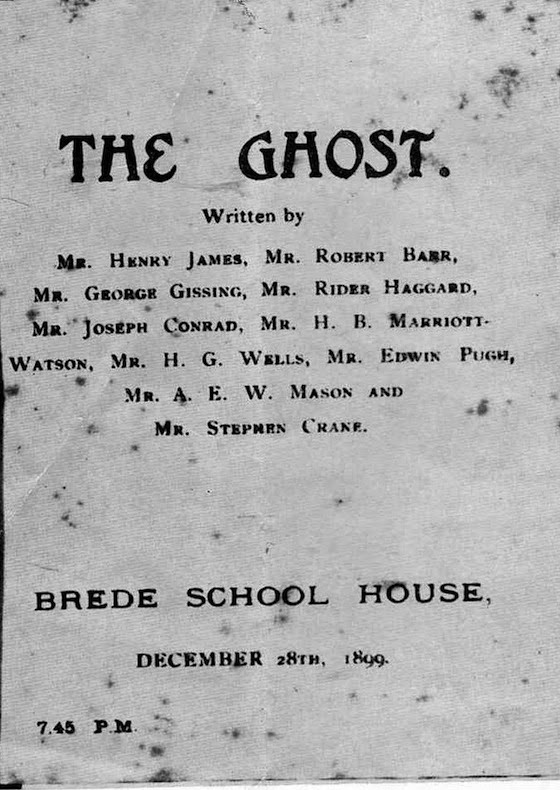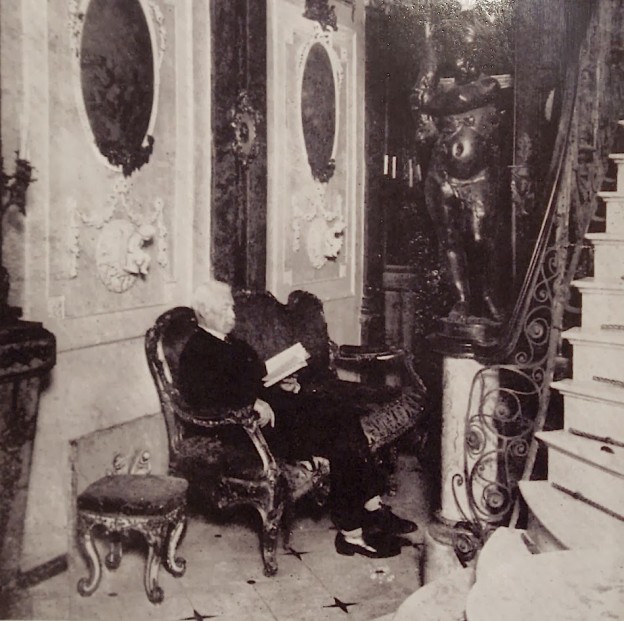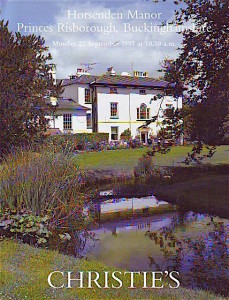From some papers relating to the Grubbe family of Priory House, Blythburgh, Suffolk and Horsenden Manor, Princes Risborought, Buckinghamshire this true ghost story with diagrams etc., The haunted Horsenden Manor is now inhabited by a rock musician, one Jay Kay of the band Jamiroquai. A Ghost Story and some Considerations thereon. L.C. Grubbe, Southwold, Suffolk. The following pages may be of service to seekers after the truth about ghosts and indeed interest many people not yet attained to the omniscience necessary in order to exclude such things altogether from the pale of possibility. I say ‘omniscience’ because in a universe so vast as ours, one must manifestly know everything that is there, before he can assent positively what is not. The discoveries constantly being made by science of secrets that for ages have lain concealed in our midst prove the immensity of the fields open to exploration as well as the dense ignorance about them in which the human mind is still wrapped. Every new fact brought to light concerning nature and her resources is as a window added to the chamber of human consciousness opening on visas of possibility never before entertained, and stretching away again into the dim haze of the absolutely unknown. What I have to relate is a very plain matter of fact story. In a secluded part of one of the midland counties stands an old country house, the home of many generations of my family, out of whose hands it passed some 60 years ago. Possibly the site has been occupied ever since Roman times, for Roman masonry was found in the foundations during alterations, but he present main building though added to and in some part of the 7th century altered is probably the same as stood during the civil wars. I am however only concerned with a certain small portion of it, which during my grandfathers time bore the reputation of being haunted, though neither he nor his children have ever been accused of undue prejudice in form of what is to my mind miscalled ‘The Supernatural’. Continue reading

A.L.Rowse and Lady Cynthia Asquith —a ghostly company

This two page letter from professional Cornishman, popular historian and alleged poet, Alfred Leslie Rowse, to ghost story compiler Lady Cynthia Asquith, came to light when I was sorting out a bunch of old letters recently. Dated March 29th and written with a ball point pen on All Souls College notepaper, its date would be 1951 or not long after. This is because in the letter Rowse thanks Lady Cynthia for remembering that he enjoyed ghost stories, by sending him a copy of her 1951 anthology, What Dreams May Come (though the book is not mentioned by name).This collection contained a number of her own stories, some of which Rowse singles out for special praise, as being not particularly ‘ghoulish‘, but instead ‘far too delicate and subtle and so beautifully written‘.
…I greatly appreciated the ‘ Olivia’ -like theme and atmosphere of ‘ The Lovely Voice’, the ‘Jane Eyre’-like ending of ‘The Playfellow’ , the conjured-up Dickensian atmosphere of ‘ The Corner Shop ‘. But the masterpiece, I thought, was the last. ‘God grante that she lye stille’ —a perfect story bewitchingly evoked. ( I think my choice betrays too my especial response to the historical & nostalgic ).
Rowse also mentions that on one occasion he took another prolific writer of ghost stories, Elizabeth Bowen, to Ireland with him and that he felt that her novel, The Last September (made into a film starring Michael Gambon 1999), was ‘ the best of her books in some ways’. With the letter Rowse sent Lady Cynthia a second hand copy of one of his own collections of ghostly tales —probably West Country Stories (1945).
Incidentally, Rowse once replied to a letter I sent him about fellow Cornishman Geoffrey Grigson by arguing that the latter, though a native of the county, was not a true Cornishman because his father came from Norfolk. I considered responding with an invitation for him to apply his theory to people born in Yorkshire, but I decided against it. [RMH]

The Ghost Man – a blurb from the 1930s

Found in the massive and unending Donald Rudd collection of detective fiction -a Gerald Verner thriller The Ghost Man (Wright and Brown, London 1936) in its sensational jacket. Gerald Verner was the pseudonym of John Robert Stuart Pringle. He had over 130 books published under four names during his lifetime and was hugely popular with his audience and a favourite of the Duke of Windsor, who was presented with an especially bound set of 15 of Verner's thrillers. He attempted to take over the mantle of the prolific (and wealthy) Edgar Wallace after his death in 1932. The jacket has elements of Wallace, even down to the style of the logo. The blurb on the inside flap reads:
Who was the man called Conner, bank robber and murderer, who was hanged at Wandsworth Prison? What connections did he have with the murderer of the Shabby Peddler in the garden of Janet Lacey's country cottage? Why did he search the place so thoroughly before he was killed? And what was the significance of the stanza from the Rubaiyat of Omar Khayyam? Mr Gerald Verner's new mystery is so full of excitement, his plots so ingenious, mysterious, and so subtly unfolded that it will be impossible to put the book down until the last word has been read.
The book is not listed by Bleiler (Supernatural Fiction) or George Locke (Spectrum of Fantasy)which would indicate the ghost is rationally explained. It is, however, an Omar Khayyam item..

A.N.L. Munby book collector, academic and ghost story writer

Found - a scarce pamphlet outlining the life of Alan Noel Latimer ('Tim') Munby (1913 - 1974). He was born on Christmas Day, hence the unused name 'Noel.' The Victorian diarist and poet Arthur Munby ('Man of Two Worlds' of Derek Hudson's book) who 'adored the roughest working-girls' and was for years secretly married to his kitchen-maid was his great-uncle. As a schoolboy and as an undergraduate (at King's College, 1932-35) he collected books; for a brief period after graduation he worked at Quaritch's bookshop. During the war he joined the Territorials (Queen Victoria Rifles); he was captured at Calais in 1940 and held as a prisoner of war in Germany for 5 years. On his return to England he worked at Sotheby's, then in 1947 was appointed College Librarian at King's. He is best known for an excellent collection of ghost stories The Alabaster Hand. Ghost fiction watchers Boucher and McComas praised the stories in The Alabaster Hand as 'quietly terrifying modernizations of the M.R. James tradition.' M.R. James was also a Cambridge academic and Cambridge produced several other writers of fantastic fiction.. The pamphlet is typical of the slim memorial papers turned out at the great universities when a distinguished or well known colleague had died.
Continue reading
Stephen Crane and a Sussex Ghost
What is it about young ex-pats writing single performance plays performed by amateurs at Christmas? A recent Jot told the story of The Princess and the Pauper, a drama by the 24 year old British humorist Harry Graham, which was performed by amateurs at Christmas 1900 in Government House, Ottawa. Exactly a year earlier, a one-off performance of The Ghost, written mainly by the 27 year old American Stephen Crane, best known for The Red Badge of Courage, was acted out by amateurs, at Brede, near Rye in Sussex.
In 1899 Crane and his wife Cora were renting Brede Place, a crumbling mainly late medieval manor house, a mile from the village, with huge fireplaces but no indoor plumbing.
Though the Cranes were enchanted by its old-world charm and maintained an open house for all and sundry, some visitors were less enamoured. One was Karl Edwin Harriman, who in print complained of the ‘chill, damp and draughts of the old house ‘, and of the wind ‘which whistled through the casements every moment of the day and night ‘. Ford Madox Ford described it in Mightier than the Sword as ‘ an ill-fated mansion…full of evil influences ‘.
Continue reading
Vincent Price sees a ghost..
Found in an anthology of supernatural encounters by the famous - I Saw a Ghost edited by Ben Noakes (Weidenfeld, 1986)- this account by Vincent Price.

On 15 November 1958 I had an extraordinary glimpse of the unknown whilst on a flight between Hollywood to New York I was immersed in a book** for most of the journey, but at one point, glanced idly out of the window. To my horror I saw huge, brilliant letters emblazoned across a cloud bank spelling out the message "TYRONE POWER DEAD". it was a terrific shock, I began to doubt my senses when I realised that nobody else on the plane appeared to have seen them, but for a few seconds they were definitely there, like huge teletype, lit up with blinding light from within the clouds. When I landed in New York I was told that Tyrone Power, had died (suddenly) a couple of hours earlier.
**In one account the book is a classic French novel - which might explain something. Also worth noting is that Power was a close friend of Price. The book bears a presentation to the artist Ronald Searle from Noakes. RS contributes a similar piece about being woken up in the South of France by Laura West Perelman the late wife of his friend Sid Perelman (and sister of Nathaniel West) who announces to him 'Sid is Dead' - the next morning he receives a call telling him that Perelman had been found dead in his hotel room in New York during that same night.

Ghosts as a symptom of dyspepsia
 |
| Frankfort-Moore in his Italian Home |
From A Mixed Grill : a Medley in Retrospect / by the author of "A Garden of Peace". London : Hutchinson, [1930.] The anonymous author was, in fact, Frank Frankfort Moore (1855–1931) an Irish dramatist, biographer, novelist and poet. Born in Limerick, Ireland, Moore worked as a journalist (1876–92) before gaining fame as an author of fiction. The frontispiece of this book shows him in his 'Italian Home' - this was actually a house in St. Leonards called 'The Campanile' filled with Italian artefacts that was on sale in 2010. On the subject of ghosts he is somewhat sceptical but most subjects, as the title implies, are seen from a slightly gastronomic viewpoint:
All the great ghost-seers on record have been also eminent dyspeptics - men and women who were deficient in pep or who had ruined their digestions by irregularity in diet or by a wrong diet. The ghost is really a symptom and it is rightly so regarded by the medical profession. We all know the sort of person who is associated with a ghost story - the ethereal girl like the sister of Sir Galahad who saw the Holy Grail - "I thought she might have risen and floated" - that girl has really risen and floated in innumerable ghost stories - the type of girl on whom that form of rash, known as the stigmata, has from time to time appeared. This may be the ghost of indulgence. In the days of gluttons there was a glut of ghosts, and there are few men of middle age to-day who have not had some experience of the man whose ghosts take the questionable shape of blue monkeys pr black cats, sometimes even of such minor crawling things as spiders or black beetles in natural colours, or, more frequently, snakes of no recognised classification. These are all the result of an over indulgence in the drug known as alcohol. Other drugs such as opium or cloral are productive of more pleasing spectral shapes; but this class of ghost has nothing in common with the phenomena of Spiritualism. Their capacity of self-expression does not go beyond the ordinary gibber. They are not worthy of serious consideration, except, of course, from the standpoint of a medical prognosis.
A humble variant is, of course, the nightmare, a horror due to such a ridiculous accident as a slipped pillow or a superfluous eiderdown, but more frequently to an incautious or a too hasty supper...

Shackleton’s Phantom Guide
Came across this article in the Winter 1948 Occult Review by the intrepid cinematographer J.C. Bee-Mason, a war photographer in France, Belgium and Russia, and cinematographer to Ernest Shackleton on his last expedition south and other Arctic expeditions. He was obsessed with bee-keeping (hence the hyphenated “Bee” in his name) and filmed documentaries about bees.There is quite a bit about him on the web including his belief that if you ate a hundred pounds of good honey every year you would live to 100. Sadly JCB only made into his early 80s. Part of the interest in the piece is the acknowledged influence of Shackleton's experience on some lines in T.S. Eliot's The Waste Land:
Who is the third who walks always beside you?
When I count, there are only you and I together
But when I look ahead up the white road
There is always another one walking beside you
Gliding wrapt in a brown mantle, hooded
I do not know whether a man or a woman
- But who is that on the other side of you?
This phenomenon has been called by the author John Geiger the 'third man factor' - the experience of people at the very edge of death who feel the presence of an incorporeal being who encourages them and guides them to safety. Geiger tells the stories of 9-11 survivors, mountaineers, astronauts, explorers and prisoners of war who have reported this feeling…
Continue reading

